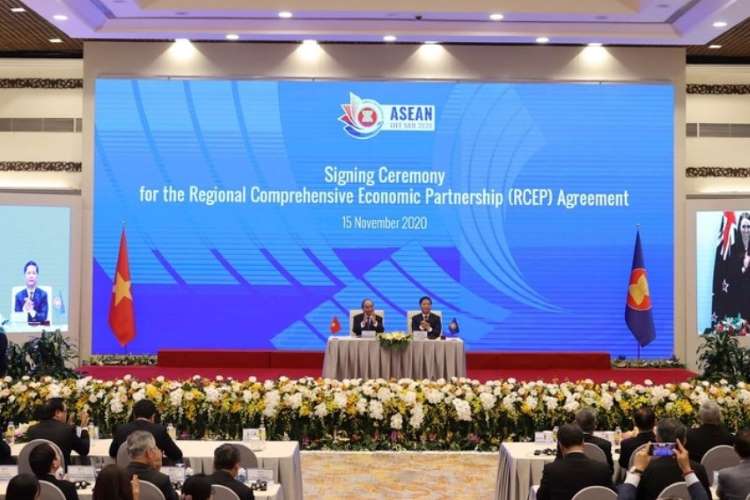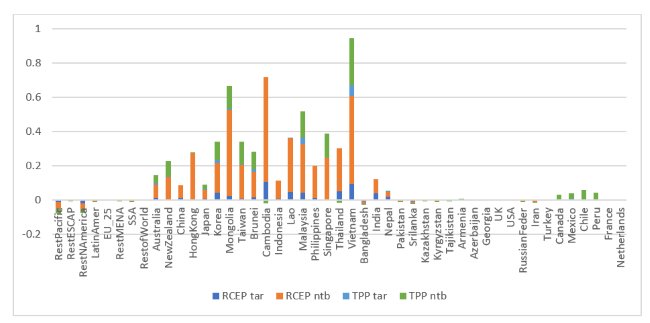
Fifteen countries in the Asia Pacific region concluded the world’s largest free trade agreement last weekend. The members of the Regional Comprehensive Economic Partnership (RCEP) account for close to 28% of world trade at around $10 trillion. India had walked out of the negotiations last year, citing threat to its industries from a possible influx of cheap goods.
When Prime Minister Modi announced India’s withdrawal from the Regional Comprehensive Economic Partnership (RCEP) agreement last year, the trade economist in me could not but remember a similar moment in recent history that announced the arrival of the new mercantilist (or nationalist, to go by Donald Trump’s words) America — the announcement by President Trump heralding the withdrawal of the US from the Trans Pacific Partnership (TPP). It is not surprising that these two decisions involving the world’s largest trade agreements and two of the largest democracies drew comparisons. This article will deal with RCEP after touching upon the similarities and differences between these announcements.
READ I RCEP: Asia Pacific trade pact will amplify Chinese power
TPP was meticulously crafted by and negotiated in favor of the US. Numerous provisions such as labour standards, intellectual property (IP) regulations, environmental standards and market access had been pushed by the Obama administration in TPP with great difficulty after lengthy negotiations. In other words, exiting TPP meant huge losses for the US producers in terms of market access, IP protection, level playing field with environmental and labour standards in poorer countries etc. The only major issue remaining was the past losses in manufacturing due to trade deals such as NAFTA, IP clauses that may affect generic drugs that are vital for the masses and some sovereignty issues surrounding the dispute settlement appellate body. However, the opponents of the deal were not many and, even the Trump voters did not care much about this deal. In such a circumstance with so little political pressure, the US could have at worst delayed the ratification by the Congress to address these minor voices of dissent. Nevertheless, President Trump withdrew from TPP immediately after coming to power.
The story was almost the opposite in the case of Indian withdrawal from RCEP. The negotiations on RCEP were not in favor of India nor had India managed to emerge as a leader during the talks. So, there weren’t too many pro-India provisions in the deal. Furthermore, Indian negotiators had persisted for seven long years, of which 5 years had been under the current dispensation, indicating the extent of effort put in by the same leadership that finally gave up. Therefore, both in terms of leadership in the agreement and in terms of the timing of the withdrawal, the two actions were far apart from each other.
READ I How can India correct trade imbalance with China
Geopolitically and strategically, however, both are comparable. Irrespective of the economic gains and losses, both the countries stood a chance to lead the world by serving as part of one of the largest value chains in the world. They both decided not to do that, owing to lack of reciprocity – a term often used by the Trump administration. Being part of a rules-making negotiation from the beginning till the end, a country has huge say in what comprises the deal. When we self-deprive of that privilege, we also lose the moral and strategic power to express our reservations on these deals at a later stage. We are already witnessing the losses faced by US farmers and industries that have lost market access in the Asia Pacific.
The report of the High Level Advisory Group on trade in India had, among other things, favored RCEP and listed its economic benefits. Similar studies were done by the US administration as well. The most famous one was done by the US International Trade Commission (USITC), predicting reasonable benefits from the TPP. These studies employed Computable General Equilibrium (CGE) models, particularly Global Trade Analysis Project (GTAP), which is a global multi-country multi-sector model and dataset.
READ I FDI from China: India must balance strategic and economic interests
Often, the opponents of these trade deals suggest that CGE models have their own defects. Indeed, every economic model does have defects. By definition, models are at best rough caricatures of the world. However, several adjustments can be made to the central assumptions of these models to take into account ground realities. Many recent CGE model studies have taken care of such developments. Irrespective of that, CGE models do not always favor free trade. They do show gains and losses in different sectors and macro variables. We have also reported GDP losses in trade liberalisation scenarios and gains in trade wars.
If anything, these models are the best available frameworks to capture the diversity of effects on different agents and sectors of the economy. Furthermore, it is true that ground realities need to be taken into account both while modeling and while interpreting results. Combining multiple approaches has own merits. From our own studies, we may infer that specific sectors in India like automotive industry, which are already in recession, may face losses due to RCEP-related tariff reductions that may result in flooding of imports. The Modi government averted such losses by withdrawing from RCEP.
READ I How India lost out to China, rest of Asia in development race
However, it is true that there will be a broader loss to the economy, particularly for the consumers who will be deprived of potentially cheaper imports. We conducted a GTAP study on GDP effects of RCEP and TPP (minus the US: widely known as CPTPP), focusing on two aspects that are being negotiated — tariff reductions (abbreviated in the following figure as TAR) and non-tariff barriers’ reductions (NTB in the figure below). Our analysis shows how much ever other countries in Asia stand to gain from RCEP and TPP, the positive effect on India is negligible. Domestic reforms, better infrastructure and efficiency improvements to strengthen the local players are prerequisites to opening up. In the absence of these, India may lose in terms of flooding of imports that may disrupt domestic production, thereby outweighing some of the gains from trade liberalisation. Realistically, since NTBs were not an important part of RCEP discussions so far, we can only discuss about the tariff reductions, which may have had negligible impact on Indian GDP (about 0.01% increase), while adversely affecting key labour-intensive sectors.

While some ambiguity and postponing tendency was expected from India, the unambiguous negative stance stopped India from being part of the largest trade deal outside WTO. The developed countries in the group were in there mainly for getting access to Indian market. For India, it may not mean much at macro level except a small negative effect due to staying out of the cost reduction and efficiency enhancement that happens in any trade deal, but many Indian industries, especially MSMEs, may feel relieved as they are saved from potential competitors from China, and even Australia/New Zealand in the case of agricultural products. On the balance, it’s a loss for India broadly, but taking into account potential losses from RCEP is also important. For India, exiting RCEP means two broad things: first, strategic and geopolitical loss that’s obvious and even potential gain that may have occurred if some RCEP members separately negotiated deals with India, increasing its strategic importance in the group. Second, economic losses and gains that were discussed earlier.
READ I e-commerce policy must focus on investment, infrastructure
A strong argument against India joining RCEP stems from the fact that the country has a trade deficit against all RCEP partners. However, seeing this from the perspective of trade balance alone may miss the bigger picture. First, consumers may gain from lower prices in any trade deal; second, domestic reforms to keep the industry competitive are a pre-requisite to benefit from the deal even in terms of trade balance; third, opening up of new venues for our exporters. In the absence of the second condition, we are left with no option but to opt out of such deals. But the fallacy here is that we are opting out due to our own domestic hindrances as discussed in the second point above. So, we are favoring less than fully efficient producers against consumers and also against efficient producers.
This is an adverse selection problem in a way. Instead, we could have facilitated the efficiency improvements in producers from a macro and sectoral perspective, and then jumped into the deal with greater bargaining power. In short, under the circumstances, India didn’t have much option other than coming out. Even now, if we calibrate domestic economic policies fostering efficiency, we can join the RCEP at a later stage. The only drawback then would be our erosion of bargaining power as we wouldn’t have been shaping it in the last few months and it’s even more likely to be skewed towards countries like China.
While both these agreements and countries are very different, and the circumstances of withdrawal were not comparable, these are steps that have far less economic implication than geopolitical and strategic implication. Again, none of this is black and white; while we have highlighted the strategic losses, this may turn out to be an opportunity for India to force ‘reciprocity’.
(Dr Badri Narayanan Gopalakrishnan is founder and director, Infinite Sum Modelling.)
Dr Badri Narayanan Gopalakrishnan is Fellow, NITI Aayog. Views expressed are personal.


